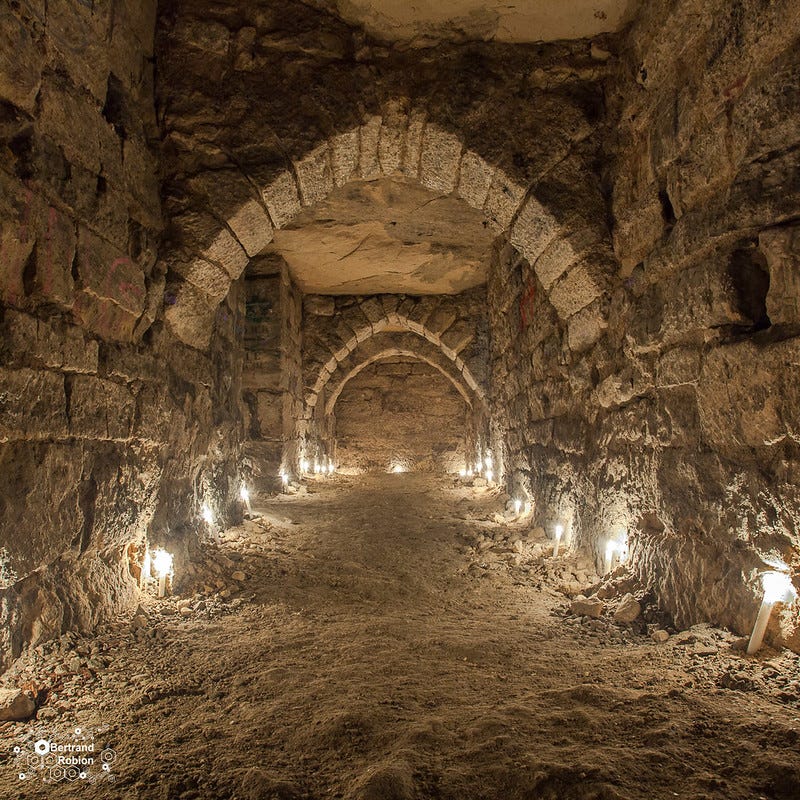Beneath Val-de-Grâce: Ghosts, Quarries, and the Lost Porter of the Paris Catacombs
Not far from the busy cafés and old bookstores of the Latin Quarter lies Val-de-Grâce, the grand old military hospital whose domed church once served as a royal abbey. Its above-ground beauty hides a much darker, quieter world below—one carved by hand, stone by stone, centuries ago.
This is the realm of the Paris Catacombs. But not the ones tourists line up for near Denfert-Rochereau. The tunnels beneath Val-de-Grâce are older, rougher, and off-limits—part of the city’s vast network of abandoned limestone quarries, long since sealed to the public.
A City Built on Hollow Ground
Paris, famously, is a city built atop itself. These tunnels supplied the stone that built Notre-Dame and many of the city’s grandest monuments. By the 18th century, cave-ins became common enough that city officials created the Inspection Générale des Carrières—a special corps charged with mapping and reinforcing the labyrinth.
Beneath Val-de-Grâce, the tunnels form a tangled maze of low-ceilinged corridors and massive stone chambers. Markers carved into the walls still bear the names of streets above—Rue Saint-Jacques, Boulevard de Port-Royal—a reminder that you’re walking under a living city.
The Legend of the Lost Porter
One of the most chilling tales from this sector comes from the early 19th century, when the tunnels still had practical (and secretive) uses. As the story goes, during one long, cold winter, a hospital porter working at Val-de-Grâce heard whispers of a hidden cache of wine and liquor stored in the tunnels during the Revolution—forgotten by the monks when their abbey was seized.
Determined to find it, he slipped away during the night, lantern in hand, descending into the quarries through an old stairway near the hospital basement.
He never returned.
Days later, after his absence was noticed, searchers found his body deep in the tunnels, not far from a section known today for its collapses and dead ends. His lantern had gone out. He’d wandered for hours in the pitch black, lost among the dripping stones and blind corners. Some versions of the tale say he’d scratched desperate messages into the walls before dying of cold and exhaustion.
Whether true or not, his story still circulates among cataphiles—urban explorers who slip through hidden entrances to wander these forbidden tunnels.
The Tunnels Today
The portion under Val-de-Grâce is sealed, though some passages remain accessible to those who know the secret paths. Many of these tunnels were used by the Resistance during World War II and are marked with old inscriptions, stone plaques, and the occasional graffiti left by later explorers.
For the city above, these tunnels are invisible—but they remain, silently supporting Paris’s weight, filled with echoes of stonecutters, soldiers, and the doomed porter who went looking for drink and found death instead.
If you enjoy my Paris stories, please consider taking a look at my series of Paris-based thrillers, The Eddie Grant Saga. Start with Treasure of Saint-Lazare, which Readers’ Favorite chose as its top historical mystery of its year.
Thanks for reading.
John Pearce
Washington, DC
Want more about Val-de-Grâce? See these links.
Off limits under Val-de-Grâce (photos)
Life Below The City Of Light: Paris Underground
Unresolved: The Missing Man In The Paris Catacombs
The Paris underground
Wikipedia: origins of Val-de-Grâce
Parisian Fields blog
photo by Bertrand Robion



